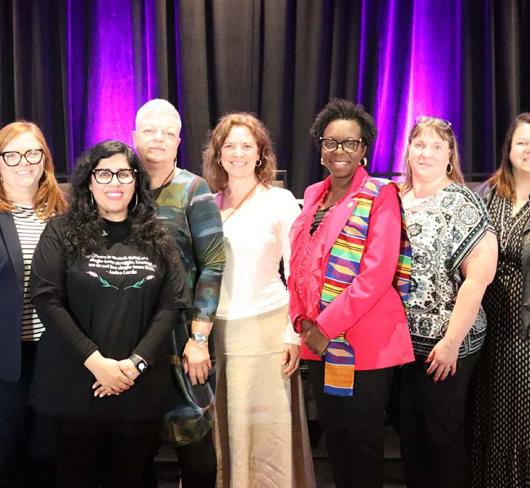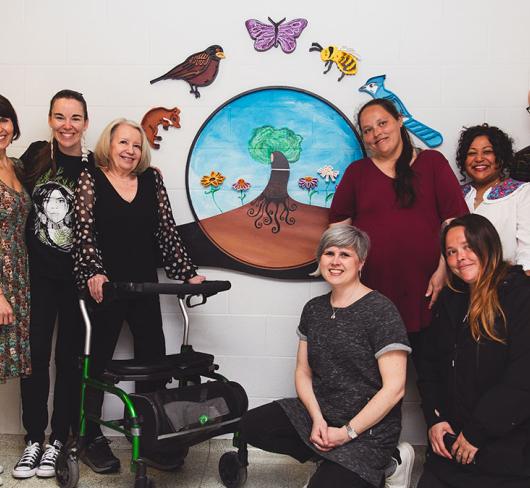ETFO Works to End Violence Against Women
As recently as 40 years ago, violence against women* was an unmentionable subject in Canada.
From 1967 to 1970, members of the Royal Commission on the Status of Women in Canada travelled around the country, charged with “inquir[ing] into . . . the status of women in Canada . . . to ensure for women equal opportunities with men in all aspects of Canadian society.” They held hearings, hired researchers, and heard from thousands of Canadian women. Their report, published 40 years ago, included 167 excellent recommendations, covering a vast range of areas where action should be taken to improve the status of women. Not one mentioned violence against women as an issue affecting women’s equality in Canada.
By 1982, our official knowledge of the issue of “battered wives” had advanced to the point that NDP MP Margaret Mitchell called on the federal government to take action on violence against women. In her book No Laughing Matter (Granville Island Publishing, 2007), she described her experience in the House of Commons:
On May 12th I rose in the House to raise the urgent need for government action on a serious and widespread issue. “The parliamentary report on battered wives states that one in ten Canadian husbands beat their wives regularly,” I began. Before I could continue, an uproar of male shouts and laughter erupted, making it impossible for me to be heard. A nearby Tory joked, “I don’t beat my wife. Do you, George?” When the Speaker finally got order, I rose again in fury. “Madam Speaker, I do not think this is a laughing matter. What action will the Minister responsible for the Status of Women undertake immediately at the federal level to protect battered women?”
Today, though we have a greater understanding of the seriousness and extent of violence against women, women are no less vulnerable. Each day seems to bring new accounts of horrifying abuse of women and girls – in war zones, in repressive political and religious regimes, in our institutions, and in our homes. Woman abuse occurs in every country and every culture. It arises from and perpetuates the social, economic, and political inequality of women.
The motivation for abuse is power and control. The abuse can be physical, emotional, psychological, sexual, economic, and spiritual. Abusers use fear, humiliation, and intimidation. ETFO is a union committed to social justice, with a particular commitment to activism to improve the status of women. Eliminating violence against women has always been one strong focus of ETFO’s advocacy work. ETFO honours and supports the work of the many underfunded community agencies, shelters, and second-stage housing providers that assist women and children whose lives are affected by violence.
BREAKING THE SILENCE
Working in partnership with Springtide Resources, ETFO has offered its women members Breaking the Silence workshops since 1999. Participants learn about the dynamics of woman abuse and explore what women in violent situations need from us, as educators and as sisters. We know from this experience that many ETFO members are themselves survivors of woman abuse, and that others are currently living in abusive situations. Recognizing that violence against women cannot be eliminated by women alone, in 2005 ETFO developed a Breaking the Silence workshop that includes men.
Members attending these workshops describe how their female students continue to believe they are not equal to boys. They describe how many boys and young men act out scripts of male dominance and entitlement. Participants consistently express a need to work creatively with their colleagues, parents, and students to identify and prevent violence and abuse, and they ask for classroom resources that will help raise students’ awareness about woman abuse, counter gender stereotyping, and educate about respectful, equal relationships.
ROOTS OF EQUALITY
In response to these needs, we developed the Roots of Equality project, which was made possible in part by the Ontario government’s decision, in 2004, to make outreach to elementary teachers and students a priority as part of its Domestic Violence Action Plan. Between 2006 and 2008, in partnership with Springtide Resources and with financial support from the Ontario Women’s Directorate (OWD), ETFO members created English-language lesson plans, tip sheets for educators and parents, and workshops for grade 7 and 8 girls’ conferences. In 2010, French-language materials will be available (including the lesson plans in this issue of Voice). These materials are all available free of charge on the ETFO website etfo.ca Resources f For Teachers.
WOMAN ABUSE AFFECTS OUR CHILDREN
The focus of Woman Abuse Affects Our Children is to help those working with elementary students identify and provide support for children affected by woman abuse. In addition to resources for use in English-language elementary classrooms in Ontario, the OWD has provided funding for the workshops that ETFO has been delivering for the past three years.
Members have been sharing their learning with colleagues around the province (see the article by Clare Nixon, page 26). In the fall of 2008, all Ontario publicly funded elementary schools received copies of Woman Abuse Affects Our Children: An Educator’s Guide. All the materials, including instructional videos and resource lists, are available free of charge at curriculum.org/womanabuse.
We recognize the contributions of the OWD in helping elementary students learn to recognize and value healthy, equal relationships, and in helping elementary educators recognize and assist children living with woman abuse.
STILL WE RISE
It was women’s activism that led to the creation of the Royal Commission on the Status of Women in Canada in 1967, and since then women’s activism has led to many positive transformations in all our lives. Working with our brothers and with our community partners, we celebrate our achievements, and each other, because the work against woman abuse still needs doing! As educators, ETFO members are in a powerful position to do violence prevention through teaching and modelling respectful relationships.
*This article contains information about the abuse of women by their intimate male partners. We recognize that abuse can exist in any familial setting: men experience violence and abuse by female partners, and abuse also occurs in same-sex relationships.
The terms “violence against women,” “woman abuse,” and “gender-based violence” are used interchangeably here.
“Violence against women is a form of discrimination and a violation of human rights. It causes untold misery, cutting short lives and leaving countless women living in pain and fear in every country in the world. It harms families across the generations, impoverishes communities and reinforces other forms of violence throughout societies. Violence against women stops them from fulfilling their potential, restricts economic growth and undermines development. The scope and extent of violence against women are a reflection of the degree and persistence of discrimination that women continue to face. It can only be eliminated, therefore, by addressing discrimination, promoting women’s equality and empowerment, and ensuring that women’s human rights are fulfilled.”
- Ending Violence Against Women, Executive Summary. Report of the Secretary-General. United Nations, 9 October 2006. un.org/womenwatch/daw/vaw/launch/english/v.a.w-exeE-use.pdf.

